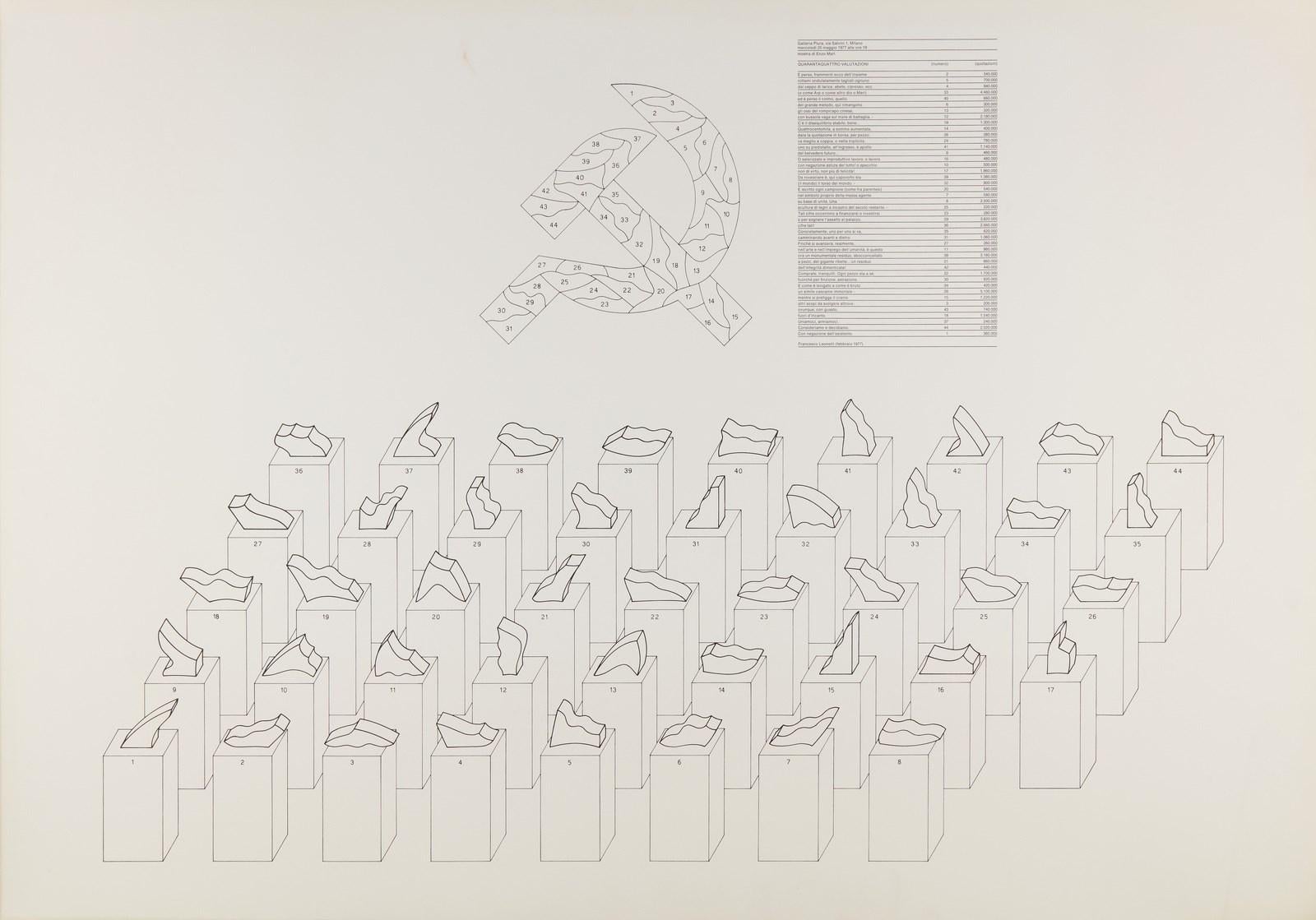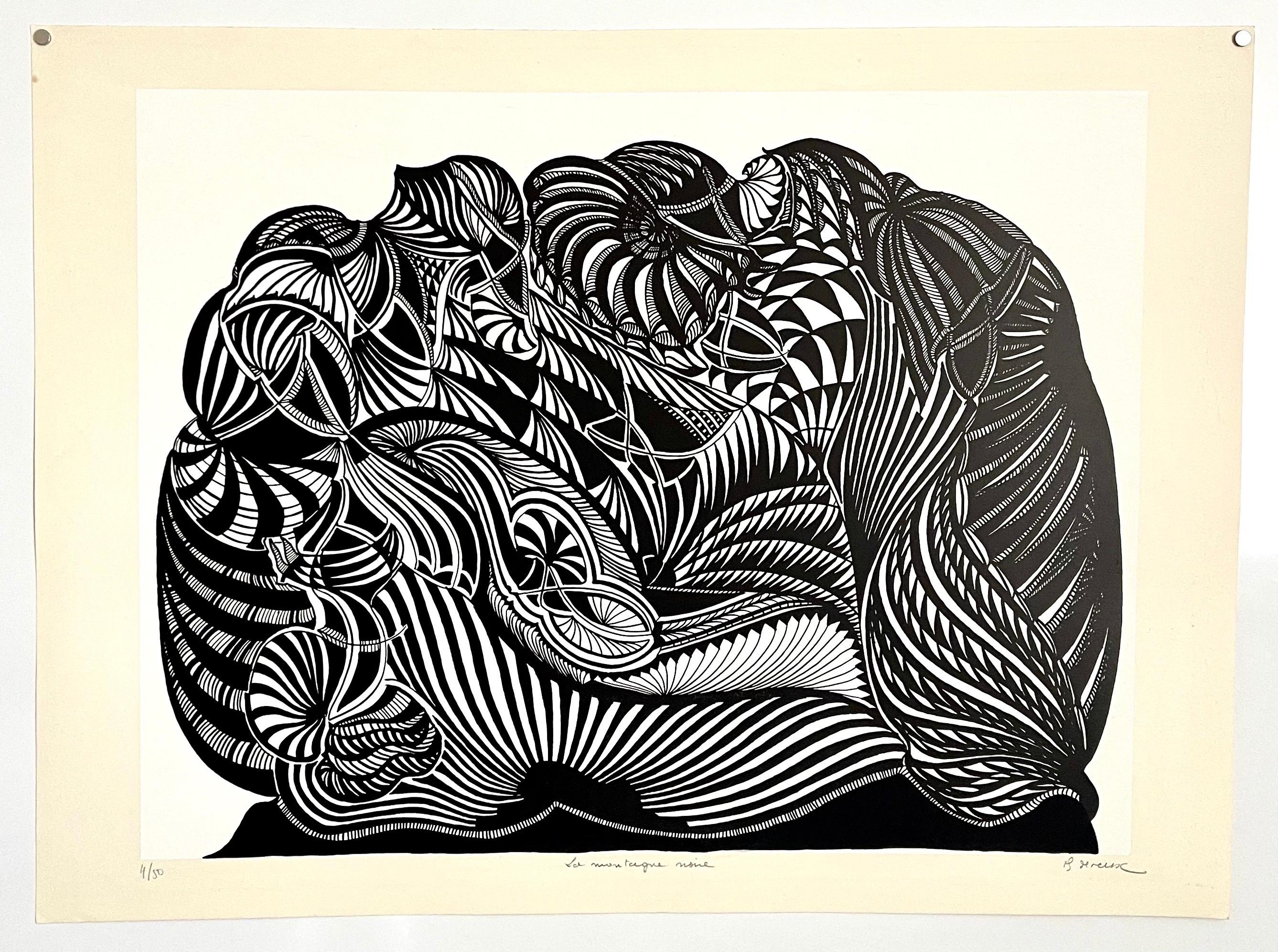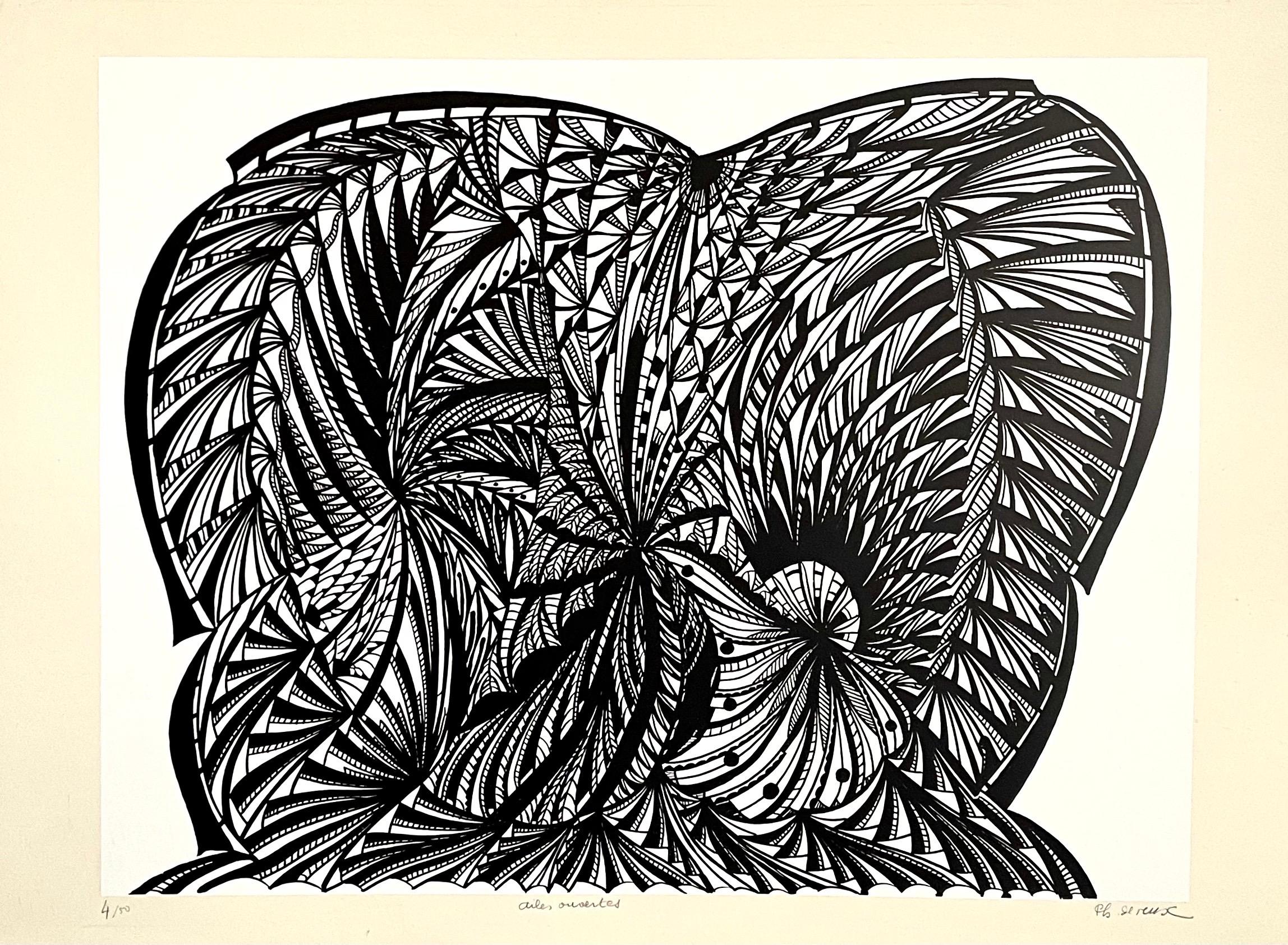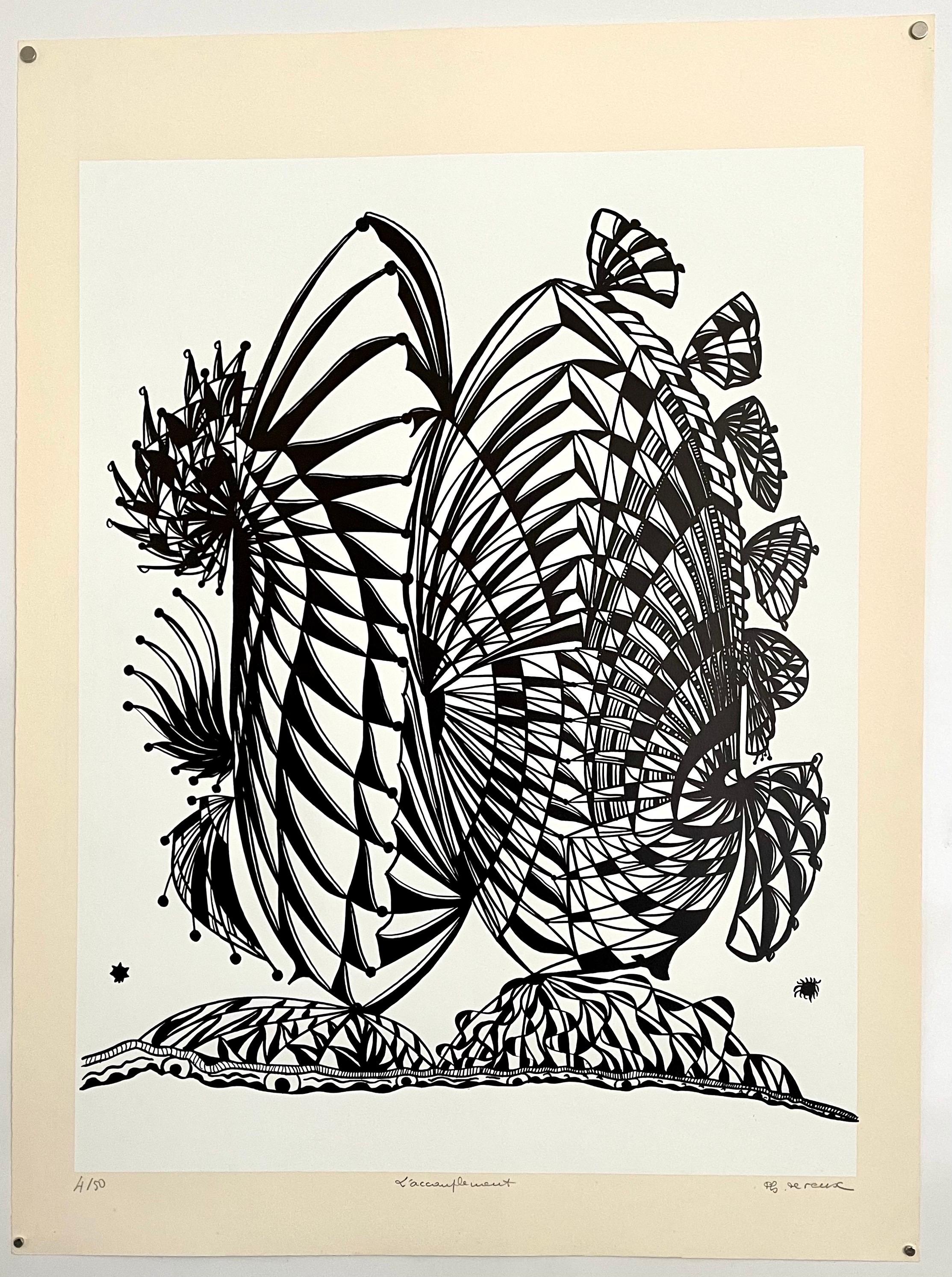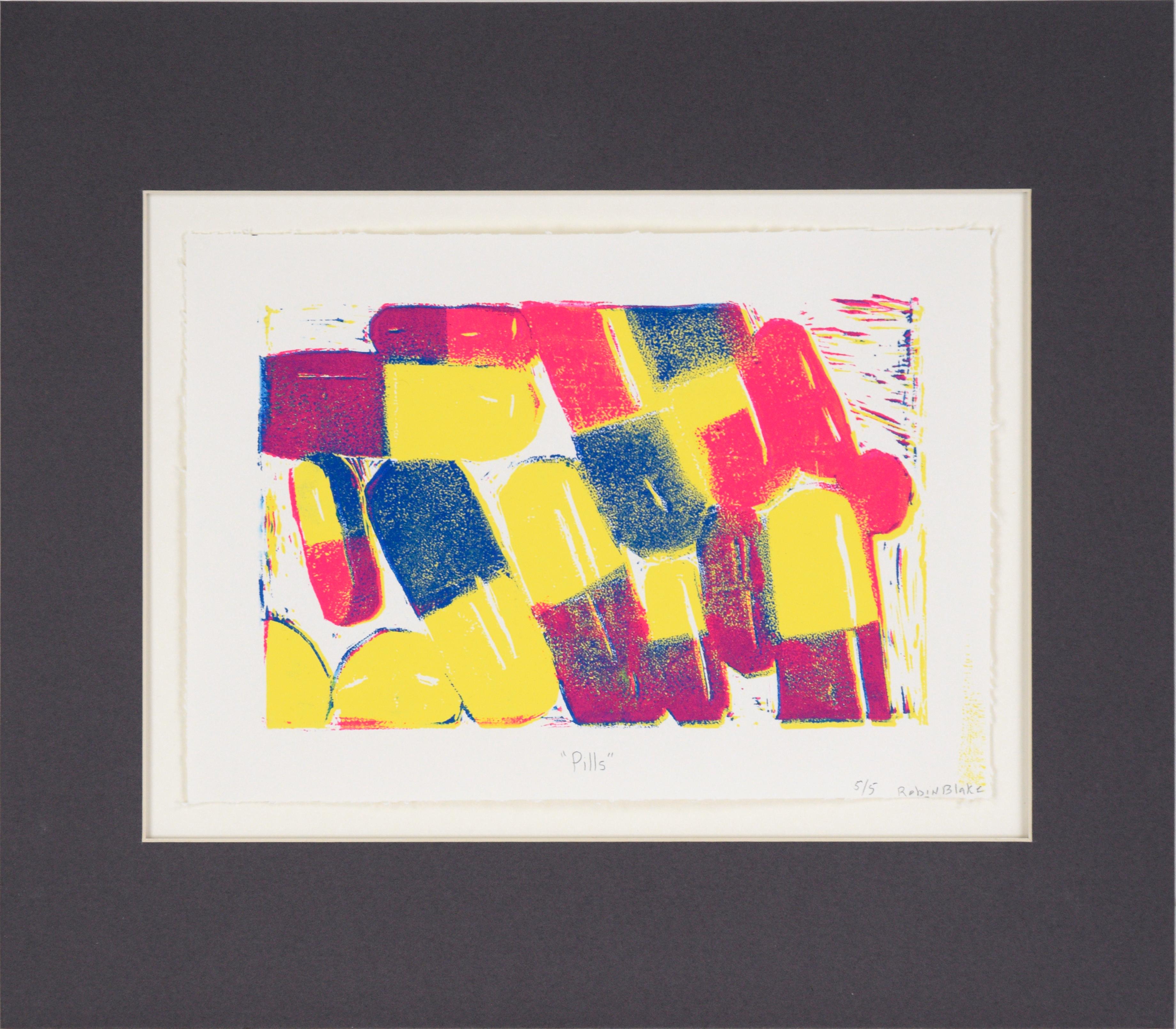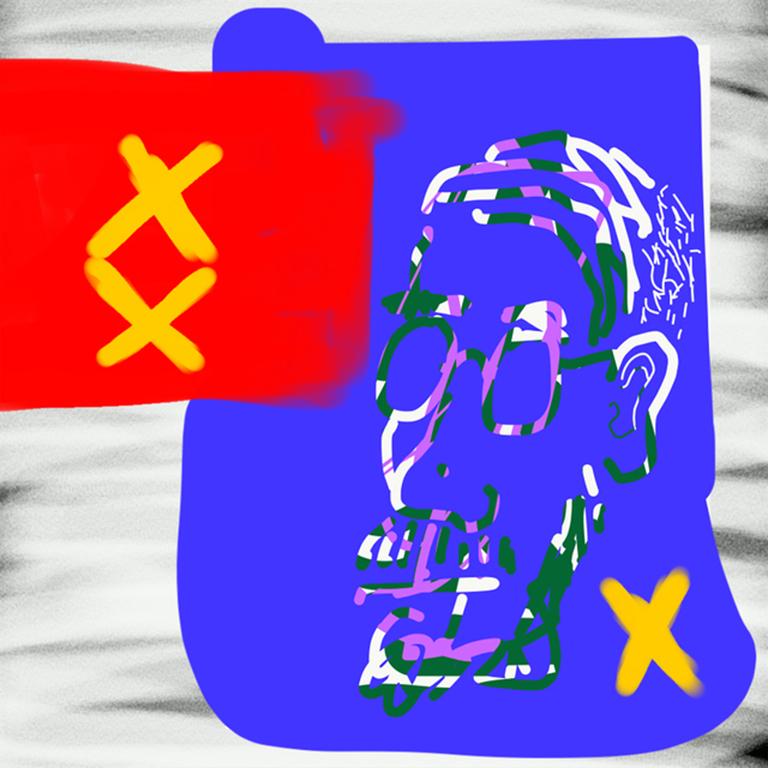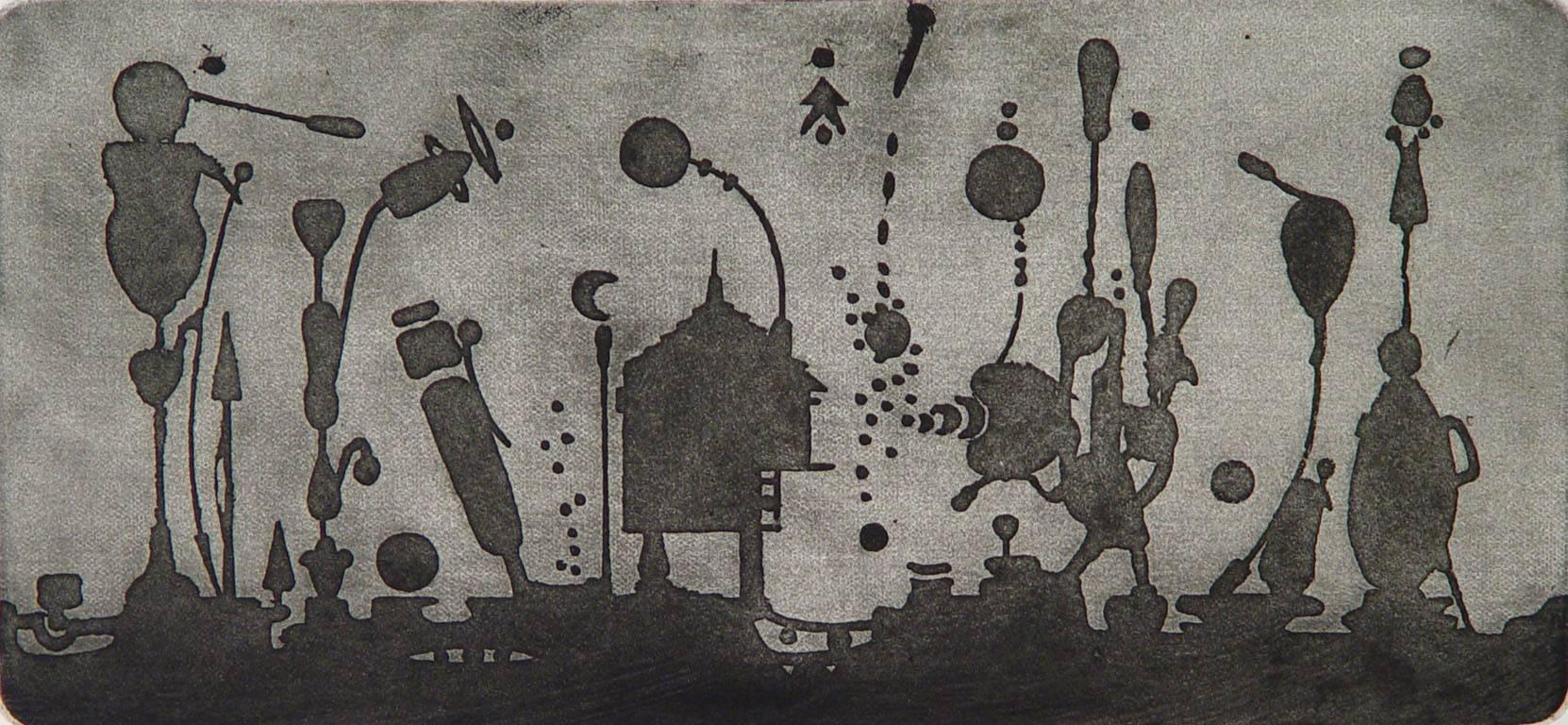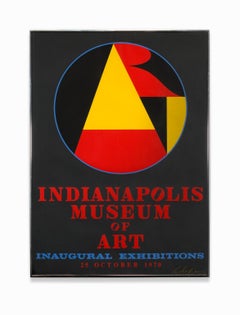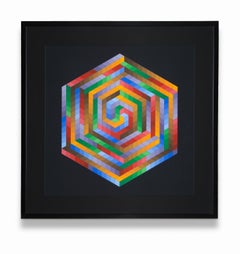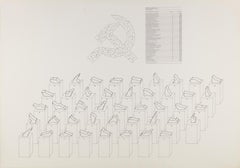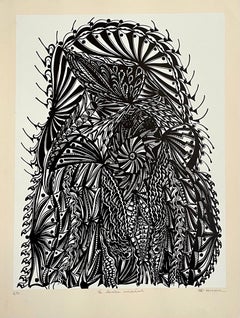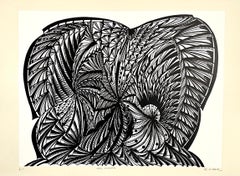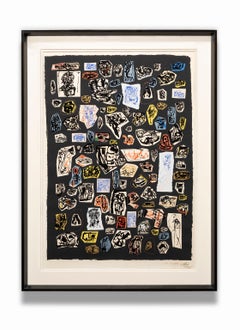
"Untitled" Collage Style Silkscreen Print, Colors, Outsider Art, Signed, Dated
View Similar Items
Want more images or videos?
Request additional images or videos from the seller
1 of 11
Antonio Saura"Untitled" Collage Style Silkscreen Print, Colors, Outsider Art, Signed, Dated1962
1962
About the Item
- Creator:Antonio Saura (1930, Spanish)
- Creation Year:1962
- Dimensions:Height: 35 in (88.9 cm)Width: 26.25 in (66.68 cm)
- Medium:
- Movement & Style:
- Period:
- Condition:
- Gallery Location:Detroit, MI
- Reference Number:1stDibs: LU128617297152
About the Seller
5.0
Vetted Seller
These experienced sellers undergo a comprehensive evaluation by our team of in-house experts.
Established in 2014
1stDibs seller since 2019
95 sales on 1stDibs
Typical response time: 4 hours
More From This SellerView All
- "Indianapolis Museum of Art Inaugural Exhibitions", Color Silkscreen, SignedBy Robert IndianaLocated in Detroit, MI"Indianapolis Museum of Art Inaugural Exhibitions", 25 October 1970, is an eye popping large bold colorful geometric abstract silk screen. It is signed on the lower right. Robert Indiana, one of the preeminent figures in American art since the 1960s, played a central role in the development of assemblage art, hard-edge painting, Pop art, Neo-Dada, American Modernism and Modern Art. A self-proclaimed “American painter of signs,” Indiana created a highly original body of work that explores American identity, personal history, and the power of abstraction and language, establishing an important legacy that resonates in the work of many contemporary artists such as Andy Warhol, Keith Haring, Roy Lectenstein, David Hockney, Romero Britto, Richard Hamilton and Robert Rauschenberg who make the written word a central element of their oeuvre. Robert Indiana was born Robert Clark in New Castle, Indiana on September 13, 1928. Adopted as an infant, he spent his childhood moving frequently throughout his namesake state. At 14 he moved to Indianapolis in order to attend Arsenal Technical High School, known for its strong arts curriculum. After graduating he spent three years in the U.S. Air Force and then studied at the Art Institute of Chicago, the Skowhegan School of Sculpture and Painting in Maine, and the Edinburgh College of Art in Scotland. In 1956, two years after moving to New York, Indiana met Ellsworth Kelly, and upon his recommendation took up residence in Coenties Slip, where a community of artists that would come to include Kelly, Agnes Martin, James Rosenquist, and Jack Youngerman had studios. Indiana, like some of his fellow artists, scavenged the area’s abandoned warehouses for materials, creating sculptural assemblages from old wooden beams, rusted metal wheels, and other remnants of the shipping trade that had thrived in Coenties Slip. The discovery of 19th century brass stencils led to the incorporation of brightly colored numbers and short emotionally charged words onto these sculptures as well as canvases, and became the basis of his new painterly vocabulary. Although acknowledged as a leader of Pop, Indiana distinguished himself from his Pop peers by addressing important social and political issues and incorporating profound historical and literary references into his works. In 1964 Indiana accepted Philip Johnson’s invitation to design a new work for the New York State Pavilion at the New York World’s Fair, creating a 20-foot EAT sign...Category
1970s American Modern Abstract Prints
MaterialsPaper, Ink, Screen
$1,760 Sale Price20% Off - Giuseppe Capogrossi Iconic Comb Design "Superficie 324" SerigrafiaLocated in Detroit, MI"Superficie 324" is a 1988 screen print (serigraph) of a 1959 painting by Capogrossi. This is one of his famous "comb" or "fork" works that he perfected in the 1950s and continued to create for the remainder of his life. The blocks of primary red and yellow colors give a bright, joyful feel and contrast to the strong bold black that was Capogrossi's consistent color for the "combs". With no allegorical, psychological, or symbolic meanings, these structural elements could be assembled and connected in countless variations. Intricate and insistent, Capogrossi's signs determined the construction of the pictorial surface. This piece is identified along one side: Giuseppe Capogrossi By SIAE 1988 Silvio Zamorani Editor Via Saccarelli, 9 10144 Torino Italy Tel. (39)(11) 4730554 Progetto Grafico (Graphic Project): Studio Walter Benjamin. Serigrafia (Screen Print): BISI Torino. Capogrossi was born in Rome. After obtaining a degree in law in 1923–1924, he decided to study painting with Felice Carena at Accademia di Belle Arti di Roma. In 1927 Capogrossi embarked on a formative trip to Paris together with fellow artists and acquaintances Fausto Pirandello, Corrado Cagli and Emanuele Cavalli...Category
1950s Abstract Expressionist Abstract Prints
MaterialsScreen
- Victor Vasarely Screen Print Abstract, Geometric Squares Cubes HexagonBy Victor VasarelyLocated in Detroit, MIVictor Vasarely born in 1906 was a Hungarian-French artist, who is widely accepted as a "grandfather" and leader of the Op Art movement. Op Art is a form of abstract art that gives the illusion of movement by the precise use of pattern and color, or in which conflicting patterns emerge and overlap. Victor Vasarely and Brigit Riley are its most famous exponents. In its visual balancing act of color and movement from a flat plane to developed continuous flow “Untitled” is a complex arrangement of squares and colors that visually expand and contract. It is one of Vasarely’s most successful Op Art abstract works. The piece is signed on the lower right and number 20/150 on the lower left. The print is behind glass and matted. Vasarely was born in Pecs and grew up in Slovakia and Budapest, where in 1925, he took up medical studies. Abandoning medicine he turned to traditional academic painting at the private Podolini-Volkmann Academy. In 1928/1929, he enrolled at Sandor Bortnyik’s private art school widely recognized as Budapest's centre of Bauhaus studies. His studies concentrated on applied graphic art and typographical design. In 1929, he painted his Blue Study and Green Study. In 1930, he married his fellow student Claire Spinner (1908–1990). Together they had two sons, Andre and Jean-Pierre. Vasarely became a graphic designer and a poster artist during the 1930s combining patterns and organic images with each other. Vasarely utilized geometric shapes and colorful graphics, the artist created compelling illusions of spatial depth, as seen in his work Vega-Nor (1969). Vasarely’s method of painting borrowed from a range of influences, including Bauhaus design principles, Wassily Kandinsky, and Constructivism. In the late 1920s, Vasarely enrolled at the Muhely Academy in Budapest, where the syllabus was largely based on Walter Gropius’s Bauhaus school in Germany. After settling in Paris in 1930, Vasarely worked in advertising agencies to support himself as a graphic artist while creating many works including Zebra (1937), which is considered by some to be one of the earliest examples of Op Art. The artist experimented in a style based in Surrealism and Abstract Expressionism during the 1940s, before arriving at his hallmark checkerboard...Category
Mid-20th Century Op Art Abstract Prints
MaterialsPaper, Screen
$1,920 Sale Price20% Off - Piero Dorazio Lithograph Abstract Geometric Quadrilateral PolygonBy Piero DorazioLocated in Detroit, MIThe work is a Lithograph, not numbered, but signed and dated by the artist, Piero Dorazio. The print has an intense color field with a strong linear element being composed of quadril...Category
1970s Abstract Expressionist Abstract Prints
MaterialsLithograph
- Jean Dubuffet Lithograph Art Brut "I. Traces grotesques"By Jean DubuffetLocated in Detroit, MISALE ONE WEEK ONLY "I. Traces grotesques" is an Artist’s Proof Lithograph. “Proofs” are either pulled or printed, and the artist has the option to work out the color and quality issues as they come out of the process. The only real difference between the two is the restricted quantity of prints bearing the AP designation and not the quality of the print. This lithograph is signed and titled by the artist, Jean Dubuffet, which indicates his complete satisfaction with the print. It is from 1958 and a perfect example of his style, “Art Brut.” His idealistic approach to aesthetics embraced what is called “low art”, art by non-academically trained artists. It is sometimes referred to as “outsider art.” He did study briefly at the Academie Julian, Paris, but eventually followed his own aesthetics which eschewed traditional standard of beauty in favor of what he believed to be a more authentic and humanistic approach to image-making. This lithograph expresses the beauty he found in the meandering spontaneous black line. Jean Dubuffet began painting at the age of seventeen and studied briefly at the Academie Julian, Paris. He painted off and on for the next 20 years. It was not until 1942 in the midst of WWII in France that he began the work which has distinguished him as an outstanding innovator in postwar Europe. It is said of his work that “he looked to the margins of the everyday – the art of prisoners, psychics, the uneducated, and the institutionalized – to liberate his own creativity and coining the term ‘Art Brut’.” Art Brut is a French term that translates as ‘raw art’, to describe art such as graffiti or naïve art which is made outside the academic tradition of fine art. His paintings from the early forties in brightly colored oils were soon followed by works in which he employed such unorthodox materials as cement, plaster, tar and asphalt-scraped, craved and cut and drawn upon with a rudimentary, spontaneous line. Dubuffet worked in France and exhibited from the early forties on. He was included in the 1946 Pierre Matisse...Category
1950s Abstract Abstract Prints
MaterialsLithograph
$3,360 Sale Price30% Off - "#24-80D Color Climb", Mixed Media Stencil Casting, Pencil Signed and NumberedLocated in Detroit, MI"#24-80D Color Climb" is an exemplary work of Paul E. Maxwell's "stencil casting" works. This abstract but grid-like work employs a thickly textured and layered surface that has also...Category
1980s Abstract Mixed Media
MaterialsMixed Media, Stencil
You May Also Like
- 44 valutazioni, 1977, Litografia, Design, PoliticaLocated in Milano, IT44 valutazioni, 1977 by Enzo Mari The work is a Lithograph on paper, 70 × 100 × 0.2 cm. Publisher is Plura Edizioni, Milan. Literature: Edition produced on the occasion of the...Category
1970s Outsider Art Abstract Prints
MaterialsLithograph
- Large 1960s French Art Brut Lithograph Bold Black & White Op Art Philippe DereuxLocated in Surfside, FLprinted by Pierre Chave, Vence, published by Bianchi Frères in Nice, France ink on watermarked chiffon de Mandeure paper, hand signed in pencil lower right, "PH Dureux," numbered 4/5...Category
1960s Outsider Art Abstract Prints
MaterialsArchival Paper, Lithograph
- Large 1960s French Art Brut Lithograph Bold Black & White Op Art Philippe DereuxLocated in Surfside, FLPrinted by Pierre Chave, Vence, published by Bianchi Frères in Nice, France ink on watermarked chiffon de Mandeure paper, hand signed in pencil lower right, "PH Dureux," numbered 4/50 lower left, titled in pencil center. This might be a silkscreen or lithograph technique. Philippe Dereux was a French artist, born in Lyon in 1918, he was a teacher by profession. Widely known and appreciated for his abstract and decorative collages based on fruit and vegetable peelings. His work was featured in exhibitions at the Collection de l'Art Brut and the Halle Saint Pierre. He was a collaborator of Jean Dubuffet in Vence in the mid-1950s, later going out on his own around 1960. Dereux's works are covered with plant elements (fruits or vegetable peels, flora and fauna). Abstract and decorative works in which he incorporated peelings of fruits, eggplants or potatoes glued with vinyl glue on cardboard and colored with gouache. He also made butterfly wing collage and assemblage works. His work, while boldly unique, bears many influences Art Brut, Outsider art, Enrico Baj, Aboriginal art, Tribal art, These works bear the influence of the black & white Op Zebra Art of Victor Vasarely and Yaacov Agam (He was collected and showed with Alphonse Chave. An art lover, dealer and collector. On November 15, 1947 in Vence, under the name Les Mages, he opened a contemporary art gallery which would also become a high place of art brut, Naive and unique art. The gallery took its final name - Galerie Alphonse Chave - in 1960. He exhibited Dado, Philippe Dereux, Jean Dubuffet, Max Ernst, Henri michaux, Louis Pons, Man ray, Dorothea Tanning, Zao Wou-ki as well as other creators.) Many public exhibitions were dedicated to him during his lifetime in Vence , Lyon , Grenoble and Paris : 1964: Fifty years of collages , Musée de Saint-Étienne, Musée des arts décoratifs de Paris. 1968: Living art, Fondation Maeght . 1984: Musée des arts décoratifs de Paris. 1985: Flaine Art Center. 1997: Neuve Invention Musée de l'art brut de Lausanne. 1999: Villefranche sur Saône cultural center and events in London and New York. 2003: Halle Saint-Pierre, Paris. Exhibitions at the Galerie Alphonse Chave in Vence: 1965: The peeling work 1968: Pure peelings, trimmed peels , paintings, lithographs. 1972: High Tension 1981-1983: XX years of peelings 1989: Theaters of peeling . 1994: The little treatise on peelings 1999: One life 2007: Retrospective of works from 1960 to 2000 2009: Exhibition Dereux / Dubuffet, Museum of Fine Arts of Lyon 2012: Philippe Dereux (1918-2001). Memories of peelings, Chave gallery, Vence. The retrospective is made up of Dereux's personal collection, many of which have never been shown. There are more than one hundred and forty works exhibited. 2014: Le Mur, works by Philippe Dereux exhibited, with the 1200 works from the Antoine de Galbert collection at La Maison rouge...Category
1960s Outsider Art Abstract Prints
MaterialsArchival Paper, Lithograph
- Large 1960s French Art Brut Lithograph Bold Black & White Op Art Philippe DereuxLocated in Surfside, FLPrinted by Pierre Chave, Vence, published by Bianchi Frères in Nice, France ink on watermarked chiffon de Mandeure paper, hand signed in pencil lower right, "PH Dureux," numbered 4/5...Category
1960s Outsider Art Abstract Prints
MaterialsArchival Paper, Lithograph
- Large 1960s French Art Brut Lithograph Bold Black & White Op Art Philippe DereuxLocated in Surfside, FLPrinted by Pierre Chave, Vence, published by Bianchi Frères in Nice, France ink on watermarked chiffon de Mandeure paper, hand signed in pencil lower right, "PH Dureux," numbered 4/5...Category
1960s Outsider Art Abstract Prints
MaterialsArchival Paper, Lithograph
- Large 1960s French Art Brut Lithograph Bold Black & White Op Art Philippe DereuxLocated in Surfside, FLPrinted by Pierre Chave, Vence, published by Bianchi Frères in Nice, France ink on watermarked chiffon de Mandeure paper, hand signed in pencil lower right, "PH Dureux," numbered 4/5...Category
1960s Outsider Art Abstract Prints
MaterialsArchival Paper, Lithograph
Recently Viewed
View AllMore Ways To Browse
Picasso Scribble
Matisse Nuit De Noel
Mcgrath Pillows
Meridian B Silver Plate
O M Christophe
Primitive Bronze Horse India
R Woodard
Serge Poliakoff On Sale
Theo Sable
Vasarely Titan
Vasilij Kandinskij
Villa Neuve
Zales Greensboro Nc
Zales Greensboro
Zales Scottsdale
Zhou Hao
Renzo Bussotti On Sale
Frank Stella Sinjerli
